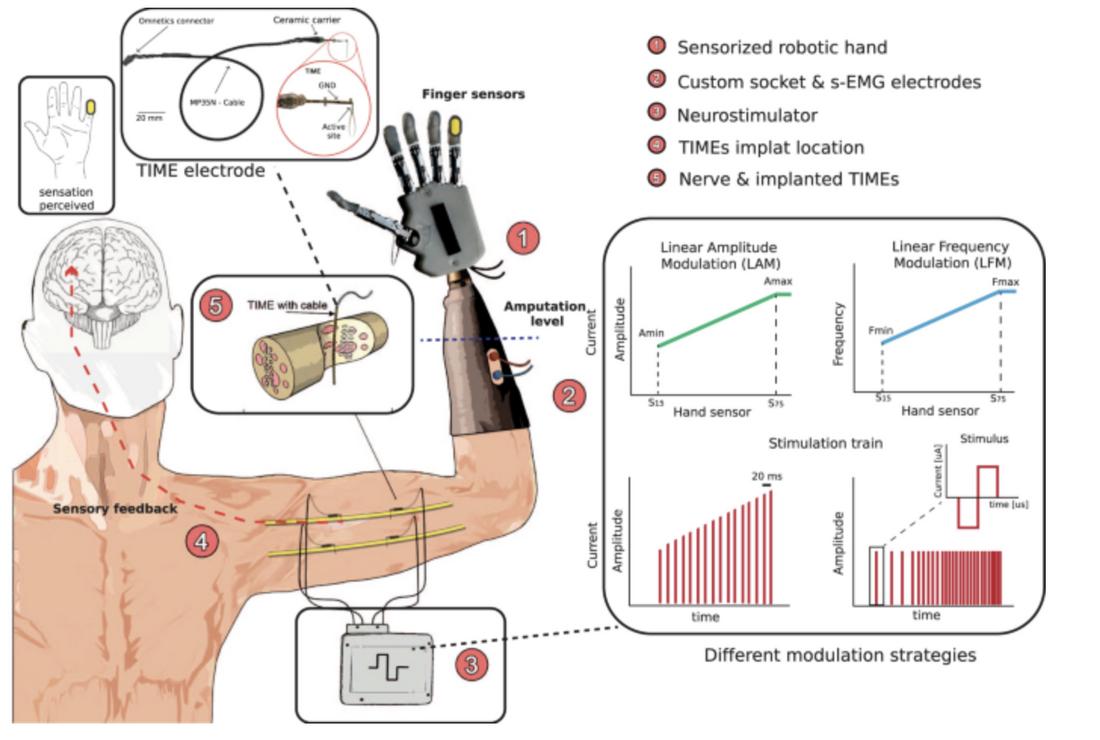Unveil the neural mechanisms behind the adaptation to neurostimulation (in collaboration with the D-HEST - Prof. Stanisa Raspopovic)

Bidirectional hand prosthesis [1].
Direct nerve stimulation can be used to provide sensory feedback to upper and lower-limb amputees. The sensory feedback allowed them to discriminate, during manipulation through a prosthetic hand (bionic hand), objects of different compliances and shapes, or to improve their mobility/agility while walking (bionic leg). The intensity of the elicited sensations can be modulated using the amplitude (Linear Amplitude Modulation - LAM) or frequency (Linear Frequency Modulation - LFM) of the injected stimuli.
One of the drawbacks of direct nerve stimulation is the adaptation which caused the patients to stop perceiving the restored sensations (even to low-frequency stimulation). In particular, when long-lasting trains of stimulation were delivered, the LFM stimulation (> 500 Hz) generated a fast adaptation (~ s) and can last up to tens of few minutes [1].
In this project, we want to unveil mechanisms behind the neural adaptation that occurs during intraneural neuromodulation and to emulate the neural process to prevent, in the real-time system. Although the adaptation can occur at different levels of the afferent pathway, the project goal is to investigate the neural response to Temporal Pattern stimulation at the network level [2]. The network should simulate/emulate the adaptation times of the experimental data. Initially, the network will be simulated in Brian, and afterward, it will be ported into a neuromorphic chip.
Available:
• Data adaptation time collected in 2 implanted amputees (multiple stimulating channels) - Provided by D-HEST
• Data of different neuromodulation strategies (amplitude and frequency)
• Hybrid nerve modelling (FEM+NEURON) to model the fibers recruitment to different stimulation trains (Electro-Neuro Model) – Provided by D-HEST
• Spiking simulator with chip equation
• A mixed-signal neuromorphic chip, the DYNAPSEx
Project level:
The project can start immediately as a semester/master project, or (preferred) as a master thesis
References:
[1] Valle, Giacomo, F. M. Petrini, Ivo Strauss, Francesco Iberite, Edoardo D’Anna, Giuseppe Granata, Marco Controzzi et al. "Comparison of linear frequency and amplitude modulation for intraneural sensory feedback in bidirectional hand prostheses." Scientific reports 8, no. 1 (2018): 1-13.
[2] Eles, J. R., Stieger, K. C., & Kozai, T. D. Y. (2020). The temporal pattern of Intracortical Microstimulation pulses elicits distinct temporal and spatial recruitment of cortical neuropil and neurons. Journal of Neural Engineering.
Requirements
Programming skills in Python, Interest in neuronal systems (biological or artificial).
Contact
Elisa Donati: elisa (at) ini.uzh.ch